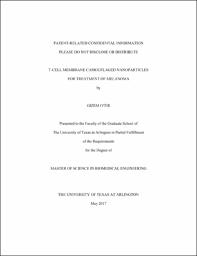
ATTENTION: The works hosted here are being migrated to a new repository that will consolidate resources, improve discoverability, and better show UTA's research impact on the global community. We will update authors as the migration progresses. Please see MavMatrix for more information.
Show simple item record
| dc.contributor.advisor | Nguyen, Kytai Truong | |
| dc.contributor.advisor | Weidanz, Jon | |
| dc.creator | Oter, Gizem | |
| dc.date.accessioned | 2019-07-09T23:54:41Z | |
| dc.date.available | 2019-07-09T23:54:41Z | |
| dc.date.created | 2017-05 | |
| dc.date.issued | 2017-05-30 | |
| dc.date.submitted | May 2017 | |
| dc.identifier.uri | http://hdl.handle.net/10106/28340 | |
| dc.description.abstract | Melanoma is one of the most aggressive skin cancers. The American Cancer Society reports that every hour, one person dies from melanoma. While there are a number of treatments currently available for melanoma (e.g. surgery, chemotherapy, immunotherapy, radiation therapy), these therapies face several problems, including inadequate response rates, high toxicity, and severe side effects due to non-specific delivery of anti-cancer drugs. To improve therapeutic efficiency and reduce these limitations, a multifunctional nanoparticle has been developed. Specifically, poly (lactic-co-glycolic acid) (PLGA) nanoparticles (NPs) were coated with a cellular membrane derived from the T cell hybridoma, 19LF6 endowed with a melanoma-specific anti-gp100/ HLA-A2 T-cell receptor (TCR) and loaded with an FDA-approved melanoma chemotherapeutic drug Trametinib. These NPs were hypothesized to have improved stealth and targeting capabilities against skin cancer cells.
T-cell membrane camuflaged trametinib loaded PLGA NPs displayed a negative average zeta potential of -36 mV and an average size of 246 nm. The particles were found to be stable for at least 2 days in 90% saline. Trametinib release profiles were affected by the amount of membrane coated onto the NPs, with the most sustained release from the NPs proportional with the highest amount of membrane used. The cytotoxicity result showed that membrane coated PLGA nanoparticles were cyto-compatible in human dermal fibroblast cells up to a concentration of 1000 g/mL. They were also hemo-compatible, with hemolysis less than 5%. In binding and cellular uptake studies, 19LF6 membrane-coated NPs displayed a significantly greater binding capacity than that of the negative controls (NPs coated with membranes from T-cells not specific to melanoma). Moreover, the binding kinetics and cellular uptake of these particles were shown to be membrane/TCR concentration dependent. Their cancer killing efficiencies were significant and aligned with binding and uptake characteristics. Particles with the higher membrane content (greater anti-gp100 TCR content) were shown to be more effective when compared to free drug and the negative controls. Based on these in vitro studies, these T-cell membrane cloaked NPs could potentially be used to improve the chemotherapeutic treatment of melanoma. | |
| dc.format.mimetype | application/pdf | |
| dc.language.iso | en_US | |
| dc.subject | Melanoma | |
| dc.subject | T-cell | |
| dc.title | T-CELL MEMBRANE CAMOUFLAGED NANOPARTICLES FOR TREATMENT OF MELANOMA | |
| dc.type | Thesis | |
| dc.degree.department | Bioengineering | |
| dc.degree.name | Master of Science in Biomedical Engineering | |
| dc.date.updated | 2019-07-09T23:54:41Z | |
| thesis.degree.department | Bioengineering | |
| thesis.degree.grantor | The University of Texas at Arlington | |
| thesis.degree.level | Masters | |
| thesis.degree.name | Master of Science in Biomedical Engineering | |
| dc.type.material | text | |
Files in this item
- Name:
- OTER-THESIS-2017.pdf
- Size:
- 3.655Mb
- Format:
- PDF
This item appears in the following Collection(s)
Show simple item record


